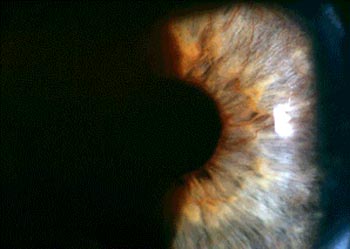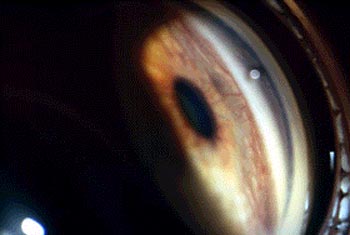Neovascular Glaucoma
Introduction
Neovascular glaucoma (NVG) is historically known as rubeotic glaucoma, from the rubeosis iridis that refers to the iris neovascularization seen with this secondary glaucoma. The most common causes of NVG are ischemic ocular diseases such as diabetic retinopathy (33% of cases), central retinal vein occlusion (33% of cases), and ocular ischemic syndrome (15% of cases). Other causes of NVG include:
- Ischemic causes – sickle cell disease, chronic retinal detachment, Coat’s disease, sickle cell, retinal hemorrhage, carotid cavernous fistula, dural shunt, Takayasu's aortitis, and radiation retinopathy
- Inflammatory – uveitis, Behcet's disease, Vogt-Koyanagi-Harada’s disease, endophthalmitis, and syphilitic retinitis
- Surgery
- Tumors – iris, ciliary body, or choroidal melanoma, retinoblastoma, and retinal lymphoma
|
The pathogenesis of NVG includes passage of angiogenic factors (such as vascular endothelial growth factor) into the anterior segment that can lead to neovascularization. These angiogenic factors are produced by ischemic, inflammatory, and carcinogenic tissue.
The mechanism of IOP elevation is the production of angiogenic factors that stimulate the formation of abnormal new vessels that have a surrounding contractile fibrovascular membrane. This membrane causes the angle to be pulled closed by peripheral anterior synechiae. Along with this secondary angle closure, new leaky blood vessels promote secondary open-angle glaucoma and may cause blockage of the trabecular meshwork.
|
Clinical Findings
Patients with NVG have various clinical symptoms and findings depending on when the diagnosis of NVG is made. Initially, patients can be fairly asymptomatic with clinical signs of neovascularization that may ultimately lead to NVG. Ophthalmologists should be aware of patients' medical history such as diabetes, atherosclerosis, or inflammatory ocular conditions that will alert them to look for signs of neovascularization. With severe prolonged disease, symptoms of acute angle closure may be prominent. This includes headache, nausea, vomiting, eye pain, and decreased vision.
Signs of neovascularization that may lead to NVG include those caused by the new vessels, such as:
- Iris neovascularization that is first seen as vascular tufts at the pupillary margin and later as tortuous vessels radiating from the pupil (Slide 1).
- Arborization of the new vessels that cross the scleral spur and run along the trabecular meshwork (Slide 2).
|
The transparent contractile fibrovascular membranes that accompany these new vessels also reflect other clinical findings:
- Effacement of normal iris architecture giving a smooth iris appearance.
- Ectropion uveae caused by a radial traction pulling the posterior pigmented iris around the pupillary margin (Slide 3).
- Secondary open-angle glaucoma as the transparent membrane covers the angle
- Peripheral anterior synechiae formation (Slide 4).
In severe NVG, the peripheral anterior synechiae can coalesce and cause 360º of angle closure and iridocorneal adhesion. This may cause signs and symptoms of acute secondary angle closure. Conjunctival injection, microcystic corneal edema, and an IOP of up to 70 mm Hg may be seen.
In NVG caused by ocular ischemic syndrome, clinical signs are similar and may also exhibit a subtle relative afferent pupillary defect. These patients may have low or normal IOPs because of poor ciliary body perfusion.
|
Diagnostic Features
The diagnosis of NVG is primarily clinical. Knowing the etiology of NVG is important because treatment of NVG is tailored toward treating the main cause. Therefore, history and careful clinical examination are critical. IOP trends, signs of anterior chamber inflammation, careful examination of the pupillary margin for small vascular tufts, fundus examination to identify the etiology, and gonioscopy to look for peripheral anterior synechiae and angle neovascularization are important.
Gonioscopy is vital because angle neovascularization may occur before iris neovascularization. Fluorescein angiography of the iris and angle may also show early leaking vessels that may not yet be clinically evident. However, clinical cost and benefit analyses have not yet shown this to be useful as a regular diagnostic tool for early neovascularization.
Fluorescein angiography of the retina is a useful tool especially in cases of posterior segment hypoxia. In proliferative diabetic retinopathy, neovascularization, capillary nonperfusion and ischemia may be documented with fluorescein angiography. Patients with diabetes should also undergo a careful clinical examination for diagnosis that is outlined above.
Fluorescein angiography is also helpful in eyes of patients with central retinal vein occlusion because it can measure the amount of retinal ischemia present.
The Central Vein Occlusion study demonstrated that retinal ischemia of greater than 10 disc diameters indicates significant risk for NVG. This study also outlined other clinical signs that help in diagnosing patients with central retinal vein occlusion at risk for NVG. Other statistically significant risk factors include male gender, initial visual acuity of <20/200, and the first 4 months after the initial occlusion. Patients with central retinal vein occlusion are at risk for what is termed the 100-day glaucoma. Eighty percent of patients with central retinal vein occlusion with NVG developed the disease in the first 4 months after the initial occlusion. Therefore, clinicians should follow patients every month in the first 6 months to evaluate the iris and angle.
Fluorescein angiography may also be useful in patients suspected to have ocular ischemic syndrome. The angiography will show decreased transit time. Patients should also receive a carotid ultrasound demonstrating stenosis of the carotid artery.
Treatment
The goals in treating NVG include:
- Controlling ischemia and halting production of angiogenic factors
- Finding alternative outflow channels
- Lowering aqueous production
- Controlling blind painful eyes
Recognizing the etiology of NVG is imperative for treatment to decrease the production of angiogenic factors. Tumors need to be irradiated or resected, and inflammation needs to be controlled with steroids.
For posterior segment hypoxia, panretinal photocoagulation has been shown to decrease ischemia and production of angiogenic factors. Several theories suggest that panretinal photocoagulation causes denaturation of tissue proteins resulting in coagulative necrosis of ocular tissue that had produced vasoproliferative factors. This leads to regression of iris and angle neovascularization. However, the exact mechanism of how panretinal photocoagulation leads to regressing neovascularization is unknown. To prevent NVG in patients with central retinal vein occlusions, the Central Vein Occlusion study demonstrated that panretinal photocoagulation is indicated when there are early signs of iris neovascularization. Panretinal photocoagulation performed before signs of iris neovascularization showed no benefit because not all patients with central retinal vein occlusion develop NVG. In diabetic retinopathy, panretinal photocoagulation is indicated when there are proliferative changes as outlined in the Early Treatment Diabetic Retinopathy Study.
Topical medications are used to lower IOP in patients with NVG. These medications include carbonic anhydrase inhibitors, beta-blockers, and alpha-2 agonists which lower aqueous production. Prostaglandin analogs may be used with caution because they may promote inflammation. In patients with NVG with secondary acute-angle closure, steroids are used to control the inflammation.
Surgical treatment may be necessary if IOPs cannot be controlled by topical medications or 360º of angle closure is present. Small case series and studies evaluate surgical treatment options. Filtering surgery with antifibrotic agents is falling out of favor for initial surgical management of NVG because of low success rates. Tube shunts have shown variable visual outcome successes and recent studies have been looking at pars plana drainage tubes with vitrectomy as surgical options.
In patients with ocular ischemic syndrome, treatment of the carotid artery stenosis with carotid endarterectomy may cause a dramatic increase in postoperative IOP because of reperfusion of the ciliary body. Therefore, panretinal photocoagulation and topical medications should be started before carotid endarterectomy.
In patients presenting with blind painful eyes caused by NVG, the goal of treatment is to increase patient comfort. Cyclophotocoagulation, which destroys the ciliary body, may be associated with hypotony and significant visual loss. Therefore, cyclophotocoagulation is reserved for eyes with low visual potential and uncontrollable high IOPs. If the eye continues to be painful, retrobulbar alcohol injection or enucleation are the final options.
Bibliography
Albert D, Jakobiec F. Principles and Practice of Ophthalmology. Philadelphia, Pa: WB Saunders; 1994:1185-1510.
Aung T, Looi ALG, Chew PTK. The visual field following acute primary angle closure. Acta Ophthal Scand. 2001;29:298-300.
Central Vein Occlusion Study Group report. A randomized clinical trial of early panretinal photocoagulation for ischemic central vein occlusion. Ophthalmology. 1995;102:1434-1444.
Central Vein Occlusion Study Group report. Natural history and clinical management of central retinal vein occlusion. Arch Ophthalmol. 1997;115:486-491.
Davis MD, Fisher MR, Gangnon RE, et al. Risk factors for high-risk proliferative diabetic retinopathy and severe visual loss: Early Treatment Diabetic Retinopathy Study Report #18. Invest Ophthalmol Vis Sci. 1998;39:233-352.
Fernandez-Vigo J, Castro J, Macarro A. Diabetic iris neovascularization. Natural history and treatment. Acta Ophthalmol Scand. 1997;75:89-93.
Gross R. Neovascular glaucoma and ocular ischemic syndrome. J Glaucoma. 2000;9:409-412.
Hamanaka T, Akabane N, Yajima T, Takahashi T, Tanabe A. Retinal ischemia and angle neovascularization in proliferative diabetic retinopathy. Am J Ophthalmol. 2001;132:648-658.
Hayreh SS, Klugman MR, Podhajsky P, Servais GE, Perkins ES. Argon laser panretinal photocoagulation in ischemic central retinal vein occlusion. A 10-year prospective study. Graefe’s Arch Clin Exp Ophthalmol. 1990;228:281-296.
Hu DN, Ritch R, Liebmann J, Liu Y, Cheng B, Hu MS. Vascular endothelial growth factor is increased in aqueous humor of glaucomatous eyes. J Glaucoma. 2002;11:406-410.
Kirchhof B. The contribution of vitreoretinal surgery to the management of refractory glaucomas. Curr Opin Ophthalmol. 1999;10:117-120.
Kubota T, Tawara A, Hata Y, Khalil A, Inomata H. Neovascular tissue in the intertrabecular spaces in eyes with neovascular glaucoma. Br J Ophthalmol. 1996;80:750-754.
Sivak-Callcott JA, O'Day DM, Gass JD, Tsai JC. Evidence-based recommendations for the diagnosis and treatment of neovascular glaucoma. Ophthalmology. 2001;108:1767-1776.
Vander JF, Duker JS, Benson WE, et al. Long-term stability and visual outcome after favorable initial response of proliferative diabetic retinopathy to panretinal photocoagulation. Ophthalmology. 1991;98:1575-1579.




